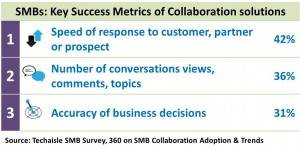Techaisle’s SMB & Midmarket Collaboration adoption research found that apart from traditional collaboration solutions of file sharing and communication, SMBs need SaaS business applications to have collaborative properties. 34 percent of SMBs and 44 percent of midmarket businesses say that SaaS applications should have built-in collaboration properties out-of-the-box. They say that the success of a cloud business application is its ability to provide /support collaboration, including email and/or hosted telephony.
Techaisle survey data shows that there is a strong connection between SaaS applications and collaboration. In some ways, these connections are intuitive: SaaS is a resource that can be accessed simultaneously by multiple individuals located anyplace where there is a network connection and cloud is inherently supportive of collaboration, and many applications are either explicitly focused on collaborative activities (ranging from SharePoint to CRM) or embed these capabilities (as with productivity applications like Office 365 or Google Apps).
Techaisle’s SMB research found quantitative support for these perceptions. When SMB respondents were asked, “what are the key attributes of a successful cloud solution?” As would be expected, security, scalability, and data management (including disaster recovery) were prominent in these responses. However, the most common answer was “the ability to support mobility,” which speaks to the requirement to enable mobile collaboration. And the fifth-most common response was “the ability to provide or support collaboration.” As the figure below shows, this is an important issue across size categories: it was cited as an important cloud success attribute by nearly half of near-enterprise (500-999 employees) firms, and also by companies with just 10-19 employees.

Further analysis of current and planned SaaS workloads underscores the importance of collaborative capabilities within SaaS applications. Techaisle asked small business and midmarket respondents who are currently using or planning to use cloud to identify the top SaaS workloads in use today, and those that are in current adoption plans. The results, that collaboration plays a role in most SaaS applications:
Workloads explicitly focused on collaboration
- Hosted VoIP (used today by 52 percent of midmarket businesses, with 35 percent planning adoption)
- Content publishing (used today by 53 percent of midmarket businesses; 56 percent of SaaS using small businesses are planning deployment)
- CRM (in use or planned by 93 percent of midmarket businesses and 71 percent of SaaS using small businesses)
Workloads where collaboration is a key differentiator, attribute or outcome
- Office suites (both Google Apps and Office 365 emphasize intrinsic collaboration capabilities. Office suites are the most commonly used SaaS application type within small business, and the third most commonly used application type within midmarket business)
- Project management (most commonly used SaaS application type within midmarket business, and the third most commonly used SaaS application type within small business)
- Business Intelligence (53 percent of midmarket businesses and 44 percent of small business are planning adoption)
Workloads where better collaboration or reporting within/across departments/functions and/or with external stakeholders is a key outcome
- Accounting/financial management and ERP (accounting/financial management is the second most widely used SaaS application type within small businesses)
- HR management (deployed by more than half of midmarket business SaaS users)
- Marketing automation (highest rate of planned adoption within midmarket business SaaS users)
These findings underscore trends that are apparent in the SMB SaaS and collaboration markets: that increasingly collaboration is important to SMBs (as a means of boosting productivity), and that cloud-based systems – including file sharing systems, and extending to SaaS applications as well – are expected to provide support for many forms of collaborative activities.
Deployment scope further impacts SMB buyer requirements
As Techaisle observes the evolution of collaborative solution capabilities within SaaS, it is important to also consider the scope across which these applications and solutions are expected to operate. Solutions that connect workers within a group or department benefit from a common understanding of context and source applications; those that connect users across groups/departments exist within a single company, and can focus on supporting IT-approved devices with reference to IT-defined security policies. Solutions that extend beyond the organization’s own staff may well offer more business impact than internal-only systems by speeding communications to customers, prospects and/or suppliers – but they come with increased issues in terms of support for seamless connectivity across multiple platforms, and potentially, may raise security concerts as well.

In the research, Techaisle asked respondents to specify the scope of their collaboration solutions. The results help clarify the strong demand for collaboration within microbusinesses, and provide insight into why businesses view collaboration as an essential solution investment area. More than 40 percent of microbusinesses, and 39 percent of all SMBs, extend their collaboration infrastructure to support for customers. Midmarket businesses are more likely to focus on internal collaboration, but they join smaller peers in having a roughly 20 percent incidence of supporting supply chain relationships (suppliers/vendors) through their collaboration systems.
Looking at the above chart, one sees that there is the potential for missed connections within the emerging panoply of collaboration-enabling systems. Social media, mobility, BI and cloud all have important collaboration extensions. But how can businesses ensure that these technologies will connect internally once they are in place? Techaisle believes that collaboration is evolving in response to this market condition. IT vendors have traditionally tried to position collaboration solutions as a platform on which businesses can create new capabilities and integrated processes. However, data shows that businesses are instead acquiring collaborative capacities as part of other applications: social media, mobility, cloud and BI all provide discrete and important – but potentially disconnected – collaboration capabilities. Moving forward, Techaisle expects that collaborative technology solutions will increasingly be positioned as a framework that integrates and extends the value of these discrete system capabilities, rather than as a “first step” platform.
Related Blogs:
SMB and Midmarket File Sharing & Collaboration Adoption to Grow by 52 percent
SMB Content Management & Collaboration Solutions Adoption: Seven Key Trends
Report details:
360 on SMB & Midmarket File Sharing & Collaboration Solutions Adoption Trends














